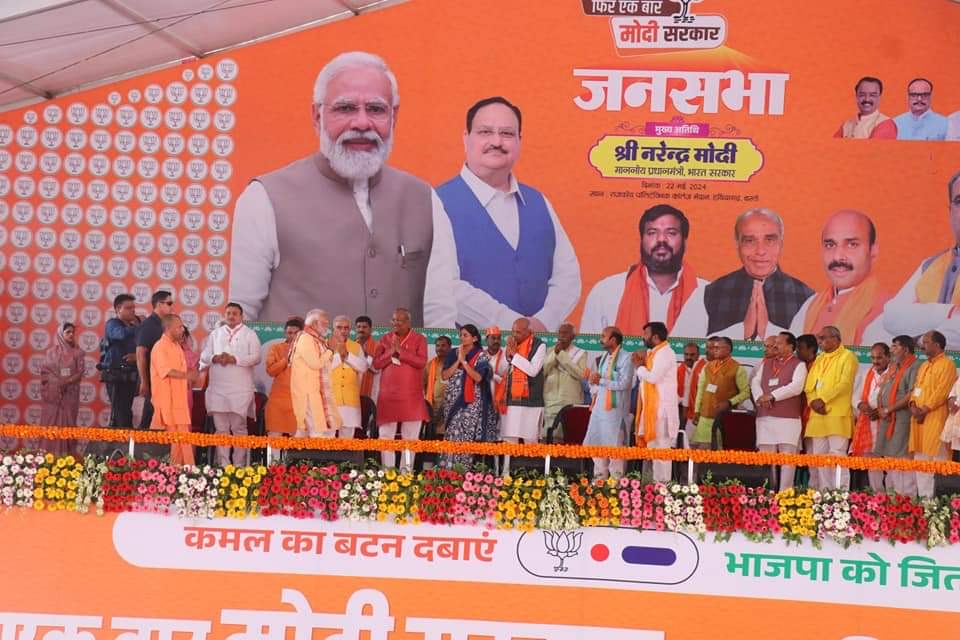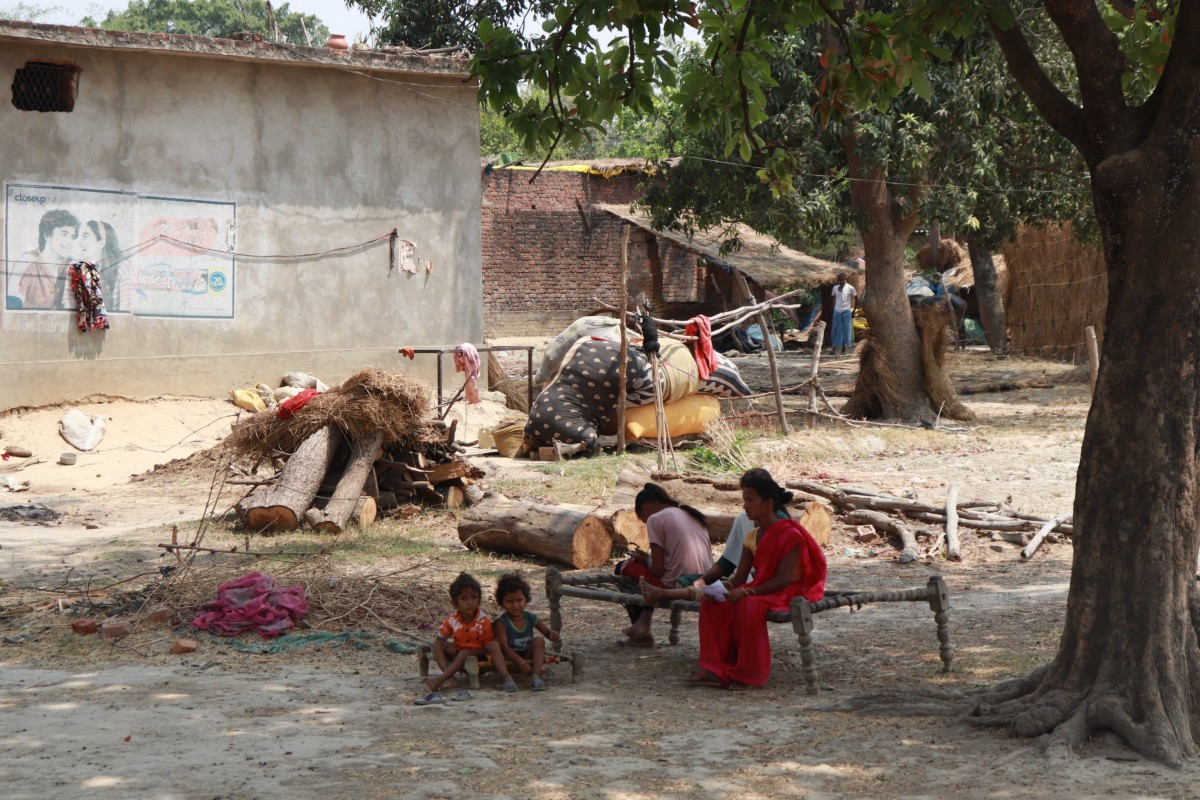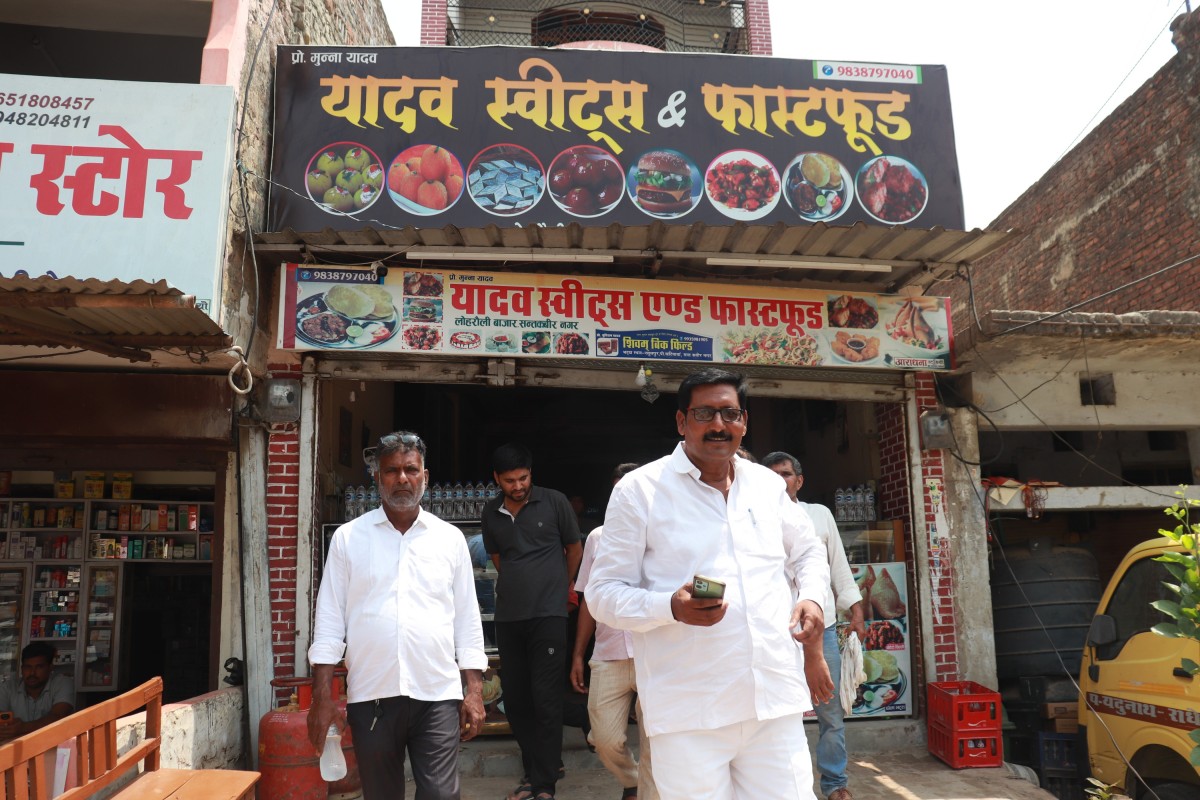UP: In Purvanchal, BJP's Alliance with Caste-Based Parties on a Shaky Ground
The road leading up to the Rajkiya Polytechnic grounds in Basti is dotted with the all too familiar cutouts of Prime Minister Narendra Modi. They hang from every pole, balancing precariously against boundary walls or standing upright to serve as selfie points. In their multitude, they conceal the real political story unfolding here.

Illustration: Pariplab Chakraborty
The politics of the last two phases of the elections in Poorvanchal or the eastern region of Uttar Pradesh does not revolve only around Modi. It is centred around the ‘ati-pichri’ or most backward castes and the BJP’s hold over this politics since 2014, which saw it power to several electoral victories, seems weakened.
The rally is primarily aimed at voters in the adjacent Sant Kabir Nagar, Basti and Domariyaganj constituencies (which poll on May 25) and the flags fluttering at the rally ground are a better indicator of how voters are being targeted. Along with the BJP’s flag, fly those of its alliance partners – the Apna Dal (Sonelal), the Suheldev Bharatiya Samaj Party (SBSP) and the Nishad Party (Nirbal Indian Shoshit Hamara Aam Dal).
On the manch, sharing the stage with the Prime Minister and chief minister Adityanath are the founders of these parties – Anupriya Patel of the “Kurmi party” Apna Dal (S), Om Prakash Rajbhar, a prominent leader of the Rajbhars, and Sanjay Nishad who formed the Nishad Party. Each of these leaders claims the affiliation of their subcastes or jati, and all three are cabinet ministers – Anupriya Patel in the Modi government, and Om Prakash Rajbhar and Sanjay Nishad in UP.

Sharing the dais with Modi, leaders of Purnvanchal’s caste parties - Om Prakash Rajbhar, Sanjay Nishad, Anupriya Patel and others. Photo: VP News Live
This is a formidable lineup of leaders from the ‘ati pichra (most backward)’ jatis, and their support has been one major part of the BJP’s success story in UP.
Anupriya Patel, who formed the breakaway Apna Dal (Sonelal) faction after a family feud, is contesting the Mirzapur seat, which polls on June 1. It was her victory in 2012 from Rohaniya, an assembly segment in Varanasi that first brought her political prominence. Since then, in an alliance with the BJP, she won the Mirzapur seat both in 2014 and 2019. In the 2022 UP Assembly elections, her party won 12 seats and is now contesting two parliamentary seats in the 2024 Lok Sabha.
Om Prakash Rajbhar founded the SBSP in 2002 after leaving the BSP. In the 2022 Assembly polls, the party, in alliance with the Samajwadi Party, won six seats, retaining Zahoorabad – Om Prakash Rajbhar’s own seat. His hold over the votes of the Rajbhars, an extremely backward caste in the OBC category, saw him inducted into the Adiyanath cabinet in March.
The Rajbhars are estimated to be anywhere between 2% to 3% of UP’s population, but as they are concentrated in eastern Uttar Pradesh they impact at least 20 Lok Sabha seats. In about 10 of these, they number over 2 lakh.
Om Prakash Rajbhar’s son Arvind Rajbhar is contesting the 2024 elections from Ghosi which polls on June 1. Sanjay Nishad’s son Praveen is the sitting MP from Sant Kabir Nagar. He won on a BJP ticket in 2019, a year after hitting national headlines as the 'Goliath' who beat the BJP in their own bastion Gorakhpur while contesting on a Samajwadi Party ticket. This was largely due to the consolidation of the Nishad vote in the constituency.
Weakening hold over community votes
Against this background, the presence of such leaders should guarantee the BJP's success here but this no longer seems to be the case. “Undeniably, these leaders carry clout but equally undeniably their power is slipping,” says Sandeep Nishad from Ahirauli village which falls in Sant Kabir Nagar “When the results come, you’ll see, Sanjay Nishad will be unable to save his own son’s seat.”
Sandeep, in his thirties, claims many among the youth in his community are disillusioned with the Nishad Party.
Abhay Nishad, also in his early thirties, says, “Here, we are not interested in Hindu-Muslim.” He is referencing the legacy of Kabir, after whom the constituency is named, whose resting place in Maghar town is marked by both a mazhaar and a samadhi.
Abhay goes on to say, “We do care for the progress of the Nishad samaj. Most of us voted for Praveen Nishad last time but never again, he and his father serve their own interests and those of the BJP.” He speaks of the betrayal the community feels as none of their demands – most critically their claim to SC status – has been met.
In these elections, the Samajwadi Party in its bid to broaden its base has given a ticket to five Nishads while the BJP has put up three, including Praveen Nishad. Abhay is working for the Samajwadi candidate Laxmikant (Pappu) Nishad who won from here in 2012 and says his support is as much for its candidate as it is due to anger against the Nishad Party. “Sanjay Nishad may have started the Nishad party but he’s been swallowed up by the BJP, there is not a single candidate fighting on the party symbol.”

Piprahankar, a Nishad Village in Sant Kabir Nagar. Photo: Ananta Jain
In several villages across the Assembly segment of Medhawal in the constituency, where the Nishad population is the highest, this correspondent came across many who echo these sentiments. The disillusionment with Sanjay Nishad and his family has increased the support for Pappu Nishad. In Piparpati village, voters gather around to tell this correspondent how they tried to meet Praveen Nishad but were turned away. In contrast, Pappu Nishad’s campaign has consisted of small jan sampark sabhas held even in the more remote villages of the constituency.
In a village in Belahar block, Pappu Nishad stops to speak to a few old women, asking them to vote for the “cycle”. She points to one of the three flags on the car and asks “ee jhanda mein jharu kahiba (Why is there a broom on the flag)", Pappu patiently explains it is the Aam Aadmi Party flag, which is part of the INDIA alliance. She nods impatiently, then cautions him, “I’m giving you my vote this time but if you disappear for five years, next time I will vote the lotus again.”

Pappu Nishad of the Samajwadi Party on the campaign trail in Sant Kabir Nagar. Photo: Ananta Jain
In Majahwa, a group of Nishad men speak about an incident, earlier in the week, where Praveen Nishad was roughed up by the villagers when he began to give an election speech.
The incident took place during a traditional festival in which the community honours their boats and other implements linked to their livelihoods.
As if in confirmation of such sentiments, Ranjit Mishra, who runs a make-shift shop, selling packets of chips and biscuits, says he will vote for the BJP as will other Brahmins, but sees the ‘ati pichra’ vote in his village moving away.
In March, this correspondent attended a convention of the Nishad Party at the Constitution Club in Delhi. The founder of the party who once spoke of the Hindu religion as excluding the backward castes sat on a dais surrounded by pictures of Hindu gods and goddesses and began his speech with “Jai Shri Ram".
The correspondent met a few district-level workers of the Nishad Party who had come to the convention to express their anger at what they felt was the failure of their party to address community issues. Sanjay Nishad rebuffed them, asking one of them, Saraswati Kashyap to leave the hall.
It is difficult to tell the degree to which such voices of anger will result in electoral reversals for the BJP. In constituencies like Varanasi and its neighbouring seats, the Nishads are less likely to shift away from the BJP in significant numbers. Ravindramani Nishad, state chief of the Nishad Party, argues that for many it still matters that Sanjay Nishad as minister made their community visible, while Modi and Adiyanath continue to enjoy popularity.
But even the palpable dent to what was once a consolidated vote for the BJP will be felt keenly, coming as it does just four months after the construction of the Ram temple in Ayodhya. For decades the Sangh and the BJP have effectively worked on the Ramayana narrative to bring the Nishad into their fold – Nishad Raj, king and deity of the community, is said to have deputed a kevat or boatman to help Ram and Sita cross the river Saryu. A temple to Nishad Raj is part of the temple complex in Ayodhya.
“People are happy that the Ram temple has been built, but they’re not going to let the BJP milk it electorally,” says Harishchandra Choudhary, a Kurmi, from Ledwa Sripal village in the Dhanghata assembly segment of Sant Kabir Nagar.
The SP’s ticket distribution
“I’m not saying the Samajwadi Party is winning because I’m from the party but this time Akhilesh Yadav is outmanoeuvring the BJP at its own game,” he explains as we sit at 'Yadav Sweets and Fastfood’, one of the oldest chai and sweetshops in Sant Kabir Nagar’s Lohrauli Bazaar.

Harishchandra Chaudhary, a prominent Kurmi member of the Samajwadi party at Yadav Sweets and Fastfood’ one of the oldest chai and sweetshops in Sant Kabir Nagar’s Lohrauli Bazaar. Photo: Ananta Jain
What follows is his analysis of the political scenario in several constituencies of Poorvanchal where he sees the Samajwadi Party having an edge due to its “inclusive” ticket distribution. “The party has shed its image of being just a Yadav and Muslim party, as it has given more tickets to the 'ati pichra samaj' than the BJP.”
The BJP’s denial of tickets to Economically Backward Classes (EBC) which rallied around it is a narrative that has hit the party from the first phase of the elections onwards and has gained greater momentum in the concluding phases.
In the earlier phases, I had reported how across Baghpat, Kairana and Muzzafarnagar, a part of the once secure vote of the Kashyap community, had moved away from the BJP to the SP candidates. The Kashyaps feel betrayed by the BJP taking their vote “for granted” without giving them political participation. The anger was further compounded by the alliance with the Rashtriya Lok Dal, given that the BJP has once claimed that it was there to protect the Kashyaps from the same Jat Party. As one BJP worker from Meerut confessed, the BJP got its 300 plus seats by consolidating the EBCs, got “greedy”, and took in the Jats thinking they would get “400 paar” not realising that you can’t sail in two boats.
This is only benefitting the Samajwadi Party. “Take my Kurmi community. More than 80% voted for the BJP but this time the Samajwadi Party has given 10 tickets to the Kurmis and the Congress one in Maharganj, while the BJP has only fielded six candidates,” says Chaudhary. “The community feels betrayed by the BJP and is shifting to the SP.” He also points to the support Raja Bhaiyya, a familiar and prominent Kurmi leader has given to Akhilesh.
The possibility of a move of the Kurmis away from the BJP is a talking point on the ground, and Chaudhary adds, “The BJP tries to separate various sub-castes and our gotras, counting them separately but if you add them, we are about 12% of UP’s population.”
These may seem granular details for a national election but issues of identity have always played a major part in UP’s politics. In a village in the Dhanghata assembly segment, where more than 70 of the residents are Kurmis, an ex-pradhan speaks up, “Anupriya Patel calls herself a leader of the Kurmis but she’s just served herself, what has she done for the community? This time she might even lose her seat. She’s only focused on her career and trying to get a ticket for her husband.”
The recognition that a community got through the emergence of leaders of their own is now giving way to a demand for more substantive work for the community by these leaders.
“Ati pichron ka BJP se moh bhang ho gaya hai (the most backwards have lost their love for the BJP),” says 70-year-old Ram Prasad Choudhary, a veteran politician and one of eastern UP’s prominent Kurmi leaders who is contesting the adjoining seat of Basti on the SP ticket. A former MP from Sant Kabir Nagar, then known as Khalilabad, and a five-time MLA from the BSP, he lost the 2019 elections by a slim margin.
He joined the Samajwadi Party later that year. He says he is confident of victory because of the consolidation of the Kurmis behind him as well as large sections of other backward castes such as the Nishada. “I will also get some upper caste votes as people are tired of the arrogance of the BJP and are angry with sitting MPs.”
The Dalit vote – estimated to be a little more than 20% – is critical in his constituency. According to Ram Prasad Chaudhary, “In the last election even though there was an alliance with between the BSP-SP, large sections of the Dalits voted for the BJP. This time that vote is shifting to the Samajwadi Party.”
This move of Dalit and the most backward caste votes away from the BJP is palpable, but it is difficult to assess how big these numbers will be. The BJP is banking on the leaders of the caste parties it has taken along in alliance to deliver once again. This is exactly the image the party is seeking to project as these leaders sit on the dais along with Modi.
They still have their supporters. Carrying the yellow flag of the SBSP, Sandeep Rajbhar spoke to us as he was walking on his way to the PM’s rally in Basti. He said most in his village support Om Prakash Rajbhar and will vote for him whichever party he is with. BJP workers also point to the fact that other OBC castes like the Jaiswals, part of what’s colloquially called 'Baniya OBCs', will still line up behind the BJP.
At Mitua Bazar in Sant Kabir Nagar, where several shops owned by the Jaiswal community, Satish Kumar Jaiswal who owns a mobile story admits as much, “Jaiswals toh Bhajpayee hee hai (The Jaiswal’s are BJP supporters).” But even he is forced to admit that the Samajwadi party’s ticket distribution and its attempts to broaden its base among EBCs have created a situation where no one is able to predict who will win Sant Kabir Nagar. Irrespective of the outcome, for a staunch BJP voter to say so is itself indicative of the ground the BJP has lost.
This article went live on May twenty-fifth, two thousand twenty four, at zero minutes past seven in the morning.The Wire is now on WhatsApp. Follow our channel for sharp analysis and opinions on the latest developments.




